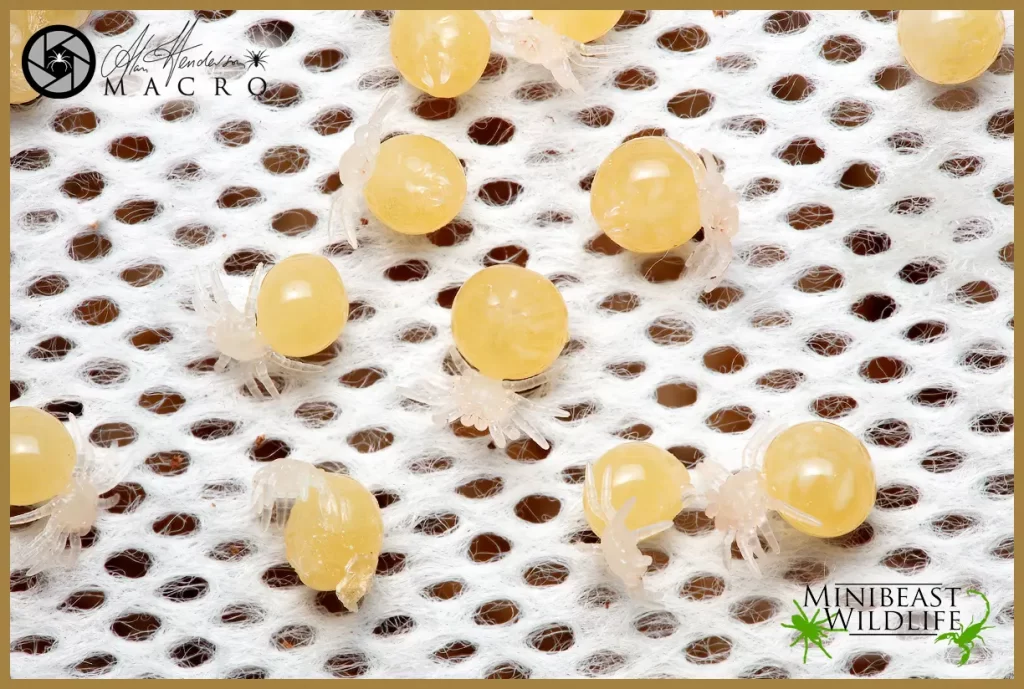
A guide to feeding Australian tarantulas
‘I just bought a tarantula and it won’t eat! What do I do?’ ‘My spider hasn’t eaten for a week! I’m freaking out – is
Each year at Minibeast Wildlife we have a busy period pairing up our tarantulas. In the wild from late summer through to early winter males are roaming looking for mates. This is typically the time when we pair up our tarantulas to breed. Each year we carefully document this process – with detailed records kept on every individual.

During the initial courtship process, the male tarantula must identify himself as a mate (not food) by a series of tapping and vibrating moves as he approaches. Each species has its own particular courtship moves. While sexual cannibalism isn’t super common in Australian tarantulas, when introducing a male into a captive female’s enclosure there is always a risk that if the male doesn’t realize he is in the presence of a female (and begin courting) that she will make a very quick meal of him. Females are more heavily built and more powerful spiders, so the males need to be on their game. When first introducing the male into the female’s enclosure, we often ensure he is aware of the female before he is completely loose in the enclosure. This is achieved by exposing him to the chemical attractants (pheromones) that each breeding age female naturally releases. He first goes into a small well-ventilated enclosure within the female’s enclosure – a device we have dubbed the ‘shark cage’. After he displays some courtship behaviour he is let loose to approach her. While this isn’t always necessary, it does help to ensure he is aware and do Even when everything goes well and mating commences there is still a risk the female may attack the male afterwards so we need to carefully monitor the whole process. Coremiocnemis spp. females are particularly aggressive towards the males as soon as the mating process ends and will often chase the male around the enclosure – our intervention often saving his life!
The actual mating process involves the male approaching the female from the front and reaching beneath her to engage her epigyne (the genital opening on the underside of her abdomen) with each of his pedipalps (one at a time). His sperm is stored in specialised organs at the end of each pedipalp and is transferred into the female via a spur-like tube during mating. Once the actual mating usually only lasts a matter of minutes, although it varies species to species and even individual to individual. Some brief matings will consist of a single pedipalp engagement, while others will involve multiple alternate engagements with each pedipalp.
Most of our female tarantulas will begin laying eggs around September, and hatching may begin near the end of October depending on when they were laid. The incubation period is around 60 days, but is dependent on the temperature the eggs are incubated at. Some egg sacs are left with the mothers to incubate and some are placed into our specialised ‘mechanical mum’ incubator which gently rotates the sacs as the mother spiders do during the first month of incubation. We also transfer some egg sacs away from the mothers just after the 30 day mark, open the sacs and use a ‘hammock style’ incubator to complete the incubation for the post embryonic (‘eggs with legs’ stage) spiderlings. The reason we do this is because some female spiders in captivity decide to eat their eggs for reasons we are yet to fully understand. While we take special care not to disturb incubating mothers at any point during this critical time, some females will still consume their eggs. This form of cannibalism can take place at any point during the incubation – even mere days before the spiderlings are ready to emerge. It is a widespread phenomenon, and tarantula breeders throughout Australia and throughout the world struggle with it at times.

Article written by
Do you like this article? Share it on your favourite platform.

‘I just bought a tarantula and it won’t eat! What do I do?’ ‘My spider hasn’t eaten for a week! I’m freaking out – is

The Semi-social Pygmy Tarantula (Coremiocnemis sp.) is a fascinating tarantula local to the Cairns region of Far North Queensland. Inhabitants of tropical rainforests, while they

It’s that time of year again at Minibeast Wildlife when we are pairing up many of our spiders, particularly our tarantulas. In the wild from

Due to the current Covid-19 pandemic, we have obviously had to suspend our physical incursion to schools in both Victoria and Queensland. In response to